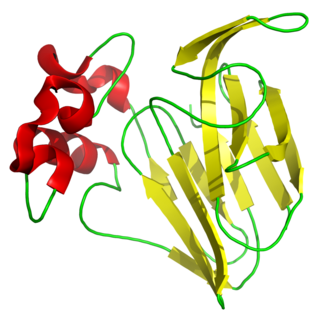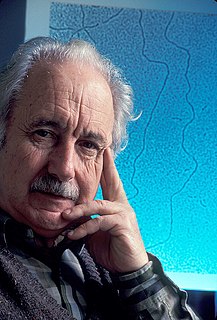Viroids are the smallest infectious pathogens known. They are composed solely of a short strand of circular, single-stranded RNA that has no protein coating. All known viroids are inhabitants of angiosperms, and most cause diseases, whose respective economic importance on humans varies widely.
Virus classification is the process of naming viruses and placing them into a taxonomic system similar to the classification systems used for cellular organisms.
Virusoids are circular single-stranded RNA(s) dependent on viruses for replication and encapsidation. The genome of virusoids consist of several hundred (200–400) nucleotides and does not code for any proteins.

Thaumatin is a low-calorie sweetener and flavour modifier. The protein is often used primarily for its flavour-modifying properties and not exclusively as a sweetener.

Theodor Otto Diener is a Swiss-American plant pathologist. In 1971, he discovered that the causative agent of the potato spindle tuber disease is not a virus, but a novel agent, which consists solely of a short strand of single-stranded RNA without a protein capsid, eighty times smaller than the smallest viruses. He proposed to name it, and similar agents yet to be discovered, viroids. Viroids displaced viruses as the smallest known infectious agents.
The Potato spindle tuber viroid ("PSTVd") was the first viroid to be identified. PSTVd is a small, single stranded circular RNA molecule closely related to the chrysanthemum stunt viroid. Present within the viroidal RNA is the Pospiviroid RY motif stem loop. The natural hosts are potatoes and tomatoes. All potatoes and tomatoes are susceptible to PSTVd and there is no form of natural resistance. Natural infections have also been seen in avocados and infections in other solanaceous crops have been induced in the laboratory. Until 2017 PSTVd was thought to be unable to infect Solanum sisymbriifolium. Then in May seeds exported by a Dutch company were noticed to be infected. These seeds were shipped from the company, but had been originally bred to their specifications in two Asian countries.
The Pospiviroidae are a family of viroids, including the first viroid to be discovered, PSTVd. Their secondary structure is key to their biological activity. The classification of this family is based on differences in the conserved central region sequence. The genome consists of an LH terminal domain, a pathogenic domain, conserved central region, variable domain, and an RH terminal domain. Pospiviroidae replication occurs in an asymmetric fashion via host cell RNA polymerase, RNase, and RNA ligase.
An EPPO code, formerly known as a Bayer code, is an encoded identifier that is used by the European and Mediterranean Plant Protection Organization (EPPO), in a system designed to uniquely identify organisms – namely plants, pests and pathogens – that are important to agriculture and crop protection. EPPO codes are a core component of a database of names, both scientific and vernacular. Although originally started by the Bayer Corporation, the official list of codes is now maintained by EPPO.
Avocado sunblotch viroid (ASBV) is a disease affecting avocado trees.
Non-cellular life, or acellular life is life that exists without a cellular structure for at least part of its life cycle. Historically, most (descriptive) definitions of life postulated that a living organism must be composed of one or more cells, but this is no longer considered necessary, and modern criteria allow for forms of life based on other structural arrangements.
Peach latent mosaic viroid is the type species of the genus Pelamoviroid, which belongs to the family Avsunviroidae. This family is characterized as having chloroplastic viroids with hammerhead ribozymes. Peach latent mosaic viroid is a 336-351nt circular RNA which has a branched formation. This branched formation is stabilised by a pseudoknot between two kissing loops. Peach latent mosaic viroid was first described in the 1980s in Spain by a group of scientists.
The Avsunviroidae are a family of viroids. There are four species in three genera. They consist of RNA genomes between 246–375 nucleotides in length. They are single-stranded covalent circles and have intramolecular base pairing. All members lack a central conserved region.

Citrus australis, the Dooja, round lime, Australian lime or Australian round lime, is a large shrub or small tree producing an edible fruit. It grows in forest margins in the Beenleigh area and northwards, in Queensland, Australia.

Karl Maramorosch was an Austrian-born American virologist, entomologist, and plant pathologist. A centenarian and polyglot, he conducted research on viruses, mycoplasmas, rickettsiae, and other micro-organisms; and their transmission to plants through insect vectors in many parts of the world. He is the co-author of a textbook on techniques in virology and is the author of numerous papers on the biology and ecology of plant viruses, their hosts, and vectors. He received the Wolf Prize in Agriculture in 1980 for his contribution to the study of crop pathogens.
The hop stunt viroid is a viroid species that infects the common hop plant, citrus plants and grapevines, among others. It is a member of the Pospiviroidae family and the Hostuviroid genus. There are quite a few different sub-species of the hop stunt viroid.
The citrus gummy bark viroid is a strain of Hop stunt viroid, and thus is a member of the genus Hostuviroid.
Citrus exocortis is a disease of citrus plants, caused by the Citrus exocortis viroid (CEVd). It can cause stunted growth and reduced yields in affected plants. The disease is also sometimes called "scalybutt". CEVd can also infect tomato plants. The resulting disease is sometimes called "tomato bunchy top disease."
Cadang-cadang is a disease caused by Coconut cadang-cadang viroid (CCCVd), a lethal viroid of coconut, African oil palm, anahaw, and buri palms. The name cadang-cadang comes from the word gadang-gadang that means dying in Bicol. It was originally reported on San Miguel Island in the Philippines in 1927/1928. "By 1962, all but 100 of 250,000 palms on this island had died from the disease," indicating an epidemic. Every year one million coconut palms are killed by CCCVd and over 30 million coconut palms have been killed since Cadang-cadang was discovered. CCCVd directly affects the production of copra, a raw material for coconut oil and animal feed. Total losses of about 30 million palms and annual yield losses of about 22,000 tons of copra have been attributed to Cadang-cadang disease in the Philippines.
Grapevine yellow speckle viroid 1 is a type of viroid that infects grapevine.



